child restraint MAZDA MODEL 3 HATCHBACK 2005 Owner's Manual (in English)
[x] Cancel search | Manufacturer: MAZDA, Model Year: 2005, Model line: MODEL 3 HATCHBACK, Model: MAZDA MODEL 3 HATCHBACK 2005Pages: 322, PDF Size: 4.7 MB
Page 5 of 322
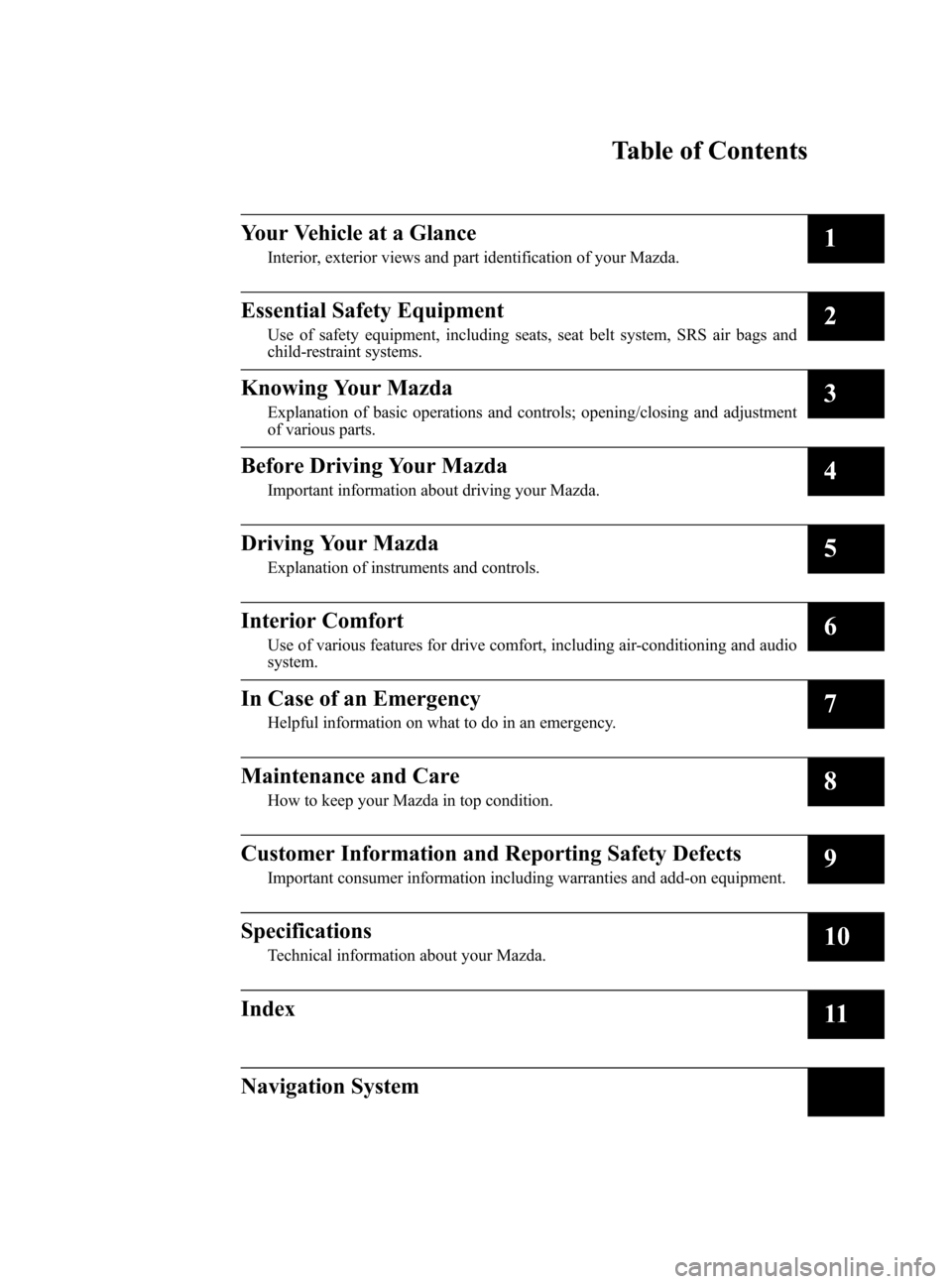
Black plate (5,1)
Mazda3_8T97-EC-04J_Edition1 Page5
Saturday, September 25 2004 2:6 PM
Form No.8T97-EC-04J
Table of Contents
Your Vehicle at a Glance
Interior, exterior views and part identification of your Mazda.1
Essential Safety Equipment
Use of safety equipment, including seats, seat belt system, SRS air bags and
child-restraint systems.2
Knowing Your Mazda
Explanation of basic operations and controls; opening/closing and adjustment
of various parts.3
Before Driving Your Mazda
Important information about driving your Mazda.4
Driving Your Mazda
Explanation of instruments and controls.5
Interior Comfort
Use of various features for drive comfort, including air-conditioning and audio
system.6
In Case of an Emergency
Helpful information on what to do in an emergency.7
Maintenance and Care
How to keep your Mazda in top condition.8
Customer Information and Reporting Safety Defects
Important consumer information including warranties and add-on equipment.9
Specifications
Technical information about your Mazda.10
Index11
Navigation System
Page 15 of 322
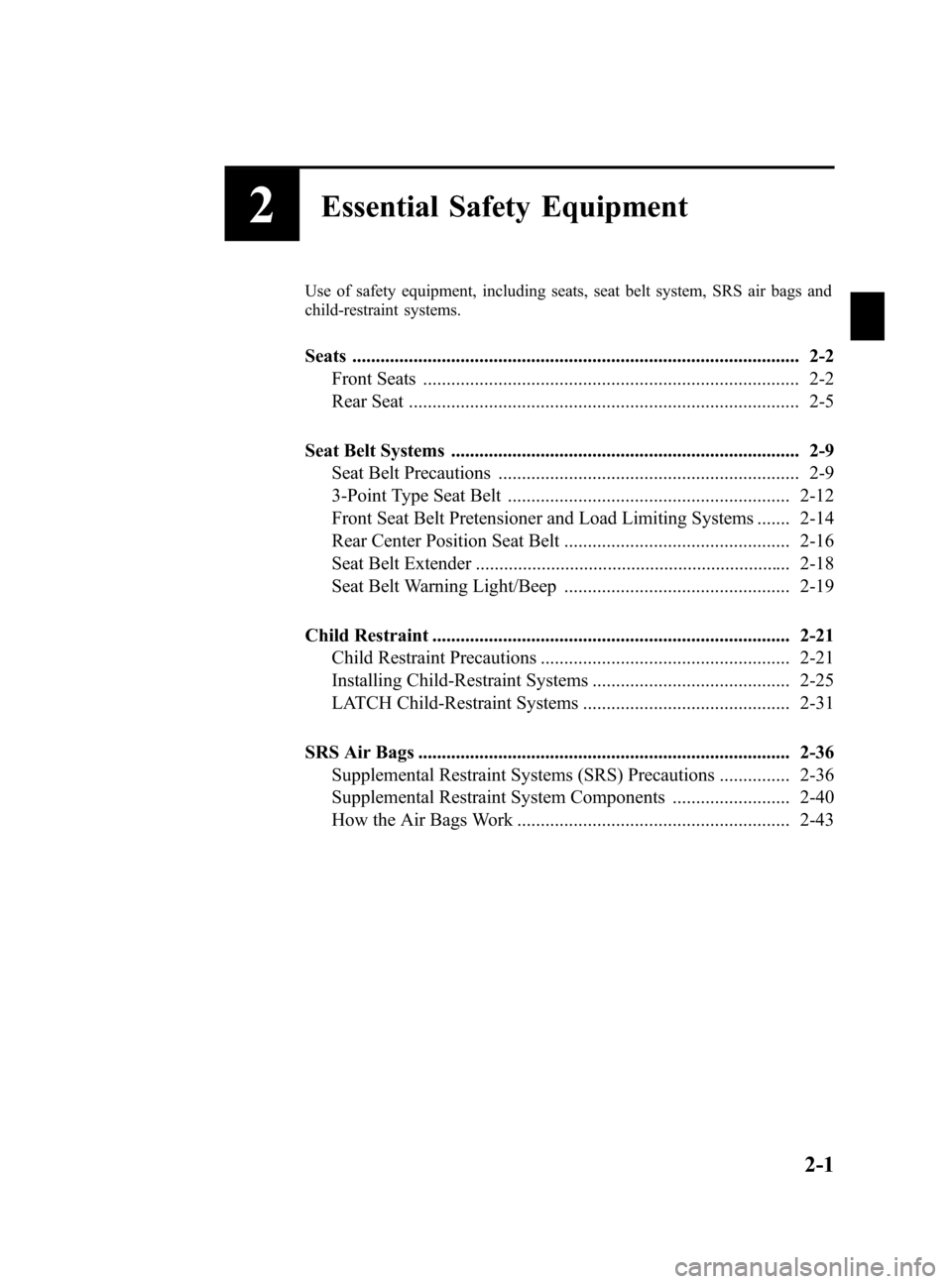
Black plate (15,1)
2Essential Safety Equipment
Use of safety equipment, including seats, seat belt system, SRS air bags and
child-restraint systems.
Seats ............................................................................................... 2-2
Front Seats ................................................................................ 2-2
Rear Seat ................................................................................... 2-5
Seat Belt Systems .......................................................................... 2-9
Seat Belt Precautions ................................................................ 2-9
3-Point Type Seat Belt ............................................................ 2-12
Front Seat Belt Pretensioner and Load Limiting Systems ....... 2-14
Rear Center Position Seat Belt ................................................ 2-16
Seat Belt Extender ................................................................... 2-18
Seat Belt Warning Light/Beep ................................................ 2-19
Child Restraint ............................................................................ 2-21
Child Restraint Precautions ..................................................... 2-21
Installing Child-Restraint Systems .......................................... 2-25
LATCH Child-Restraint Systems ............................................ 2-31
SRS Air Bags ............................................................................... 2-36
Supplemental Restraint Systems (SRS) Precautions ............... 2-36
Supplemental Restraint System Components ......................... 2-40
How the Air Bags Work .......................................................... 2-43
2-1
Mazda3_8T97-EC-04J_Edition1 Page15
Saturday, September 25 2004 2:6 PM
Form No.8T97-EC-04J
Page 20 of 322
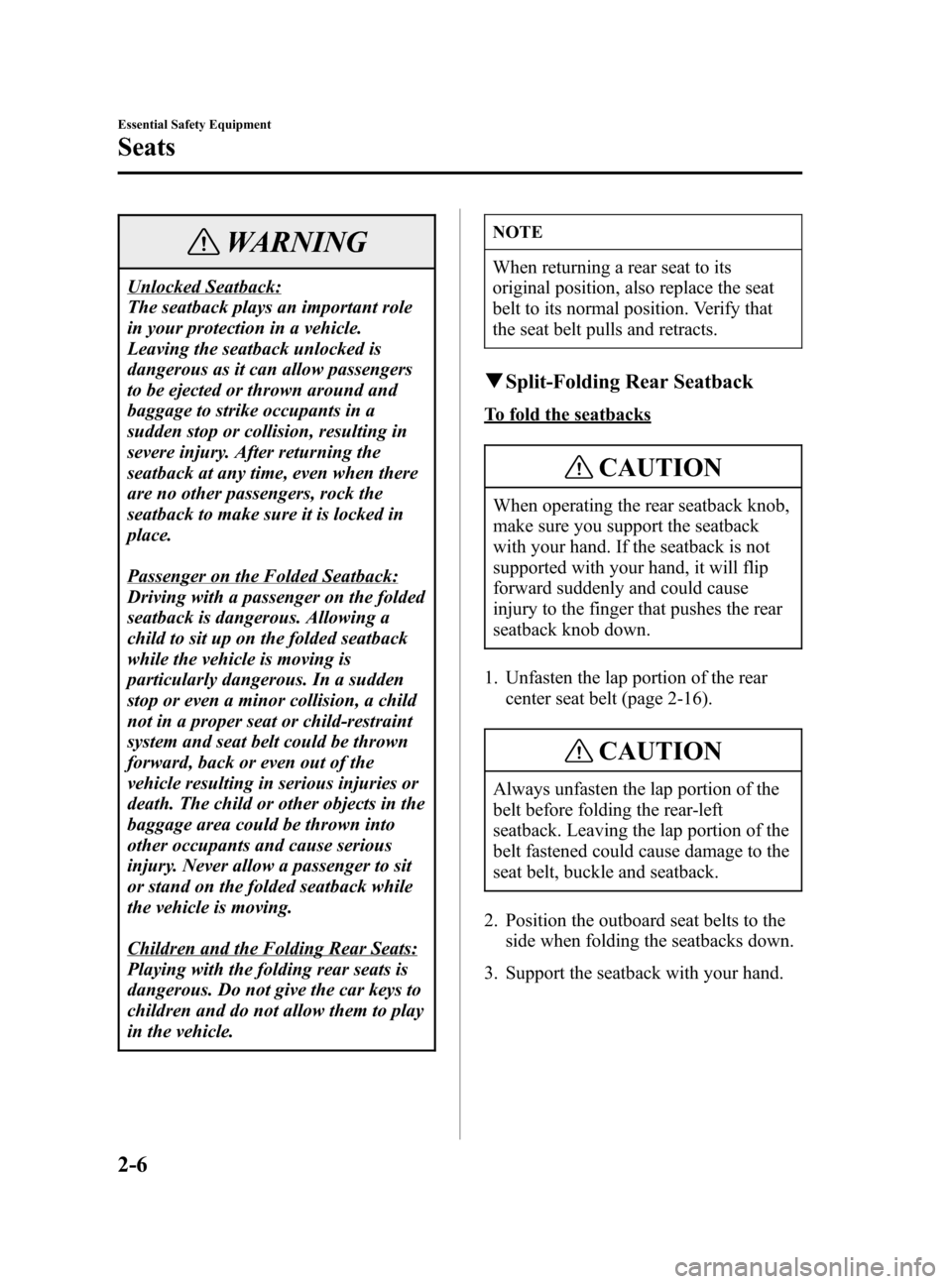
Black plate (20,1)
WARNING
Unlocked Seatback:
The seatback plays an important role
in your protection in a vehicle.
Leaving the seatback unlocked is
dangerous as it can allow passengers
to be ejected or thrown around and
baggage to strike occupants in a
sudden stop or collision, resulting in
severe injury. After returning the
seatback at any time, even when there
are no other passengers, rock the
seatback to make sure it is locked in
place.
Passenger on the Folded Seatback:
Driving with a passenger on the folded
seatback is dangerous. Allowing a
child to sit up on the folded seatback
while the vehicle is moving is
particularly dangerous. In a sudden
stop or even a minor collision, a child
not in a proper seat or child-restraint
system and seat belt could be thrown
forward, back or even out of the
vehicle resulting in serious injuries or
death. The child or other objects in the
baggage area could be thrown into
other occupants and cause serious
injury. Never allow a passenger to sit
or stand on the folded seatback while
the vehicle is moving.
Children and the Folding Rear Seats:
Playing with the folding rear seats is
dangerous. Do not give the car keys to
children and do not allow them to play
in the vehicle.
NOTE
When returning a rear seat to its
original position, also replace the seat
belt to its normal position. Verify that
the seat belt pulls and retracts.
qSplit-Folding Rear Seatback
To fold the seatbacks
CAUTION
When operating the rear seatback knob,
make sure you support the seatback
with your hand. If the seatback is not
supported with your hand, it will flip
forward suddenly and could cause
injury to the finger that pushes the rear
seatback knob down.
1. Unfasten the lap portion of the rear
center seat belt (page 2-16).
CAUTION
Always unfasten the lap portion of the
belt before folding the rear-left
seatback. Leaving the lap portion of the
belt fastened could cause damage to the
seat belt, buckle and seatback.
2. Position the outboard seat belts to the
side when folding the seatbacks down.
3. Support the seatback with your hand.
2-6
Essential Safety Equipment
Seats
Mazda3_8T97-EC-04J_Edition1 Page20
Saturday, September 25 2004 2:7 PM
Form No.8T97-EC-04J
Page 23 of 322
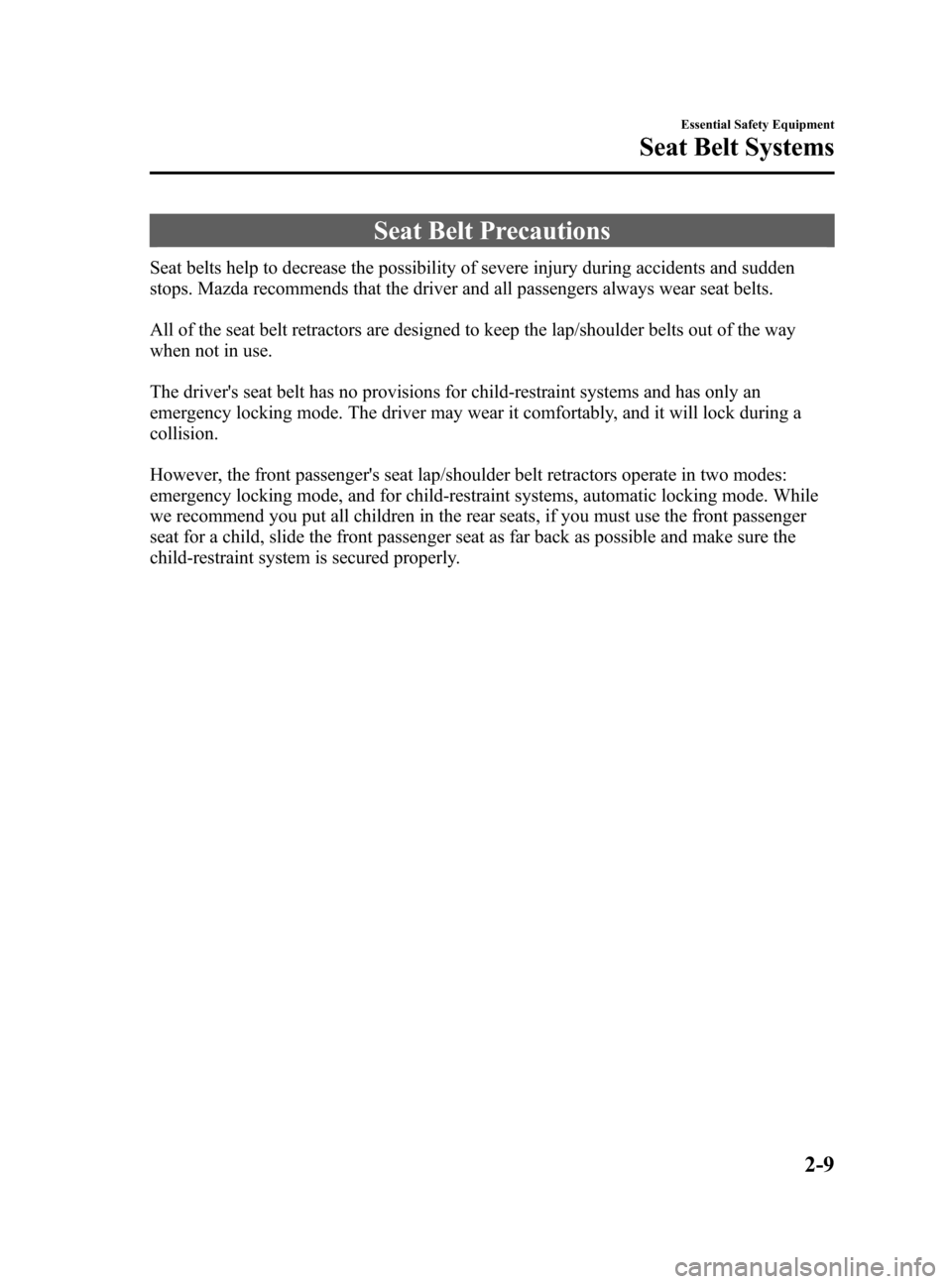
Black plate (23,1)
Seat Belt Precautions
Seat belts help to decrease the possibility of severe injury during accidents and sudden
stops. Mazda recommends that the driver and all passengers always wear seat belts.
All of the seat belt retractors are designed to keep the lap/shoulder belts out of the way
when not in use.
The driver's seat belt has no provisions for child-restraint systems and has only an
emergency locking mode. The driver may wear it comfortably, and it will lock during a
collision.
However, the front passenger's seat lap/shoulder belt retractors operate in two modes:
emergency locking mode, and for child-restraint systems, automatic locking mode. While
we recommend you put all children in the rear seats, if you must use the front passenger
seat for a child, slide the front passenger seat as far back as possible and make sure the
child-restraint system is secured properly.
Essential Safety Equipment
Seat Belt Systems
2-9
Mazda3_8T97-EC-04J_Edition1 Page23
Saturday, September 25 2004 2:7 PM
Form No.8T97-EC-04J
Page 25 of 322
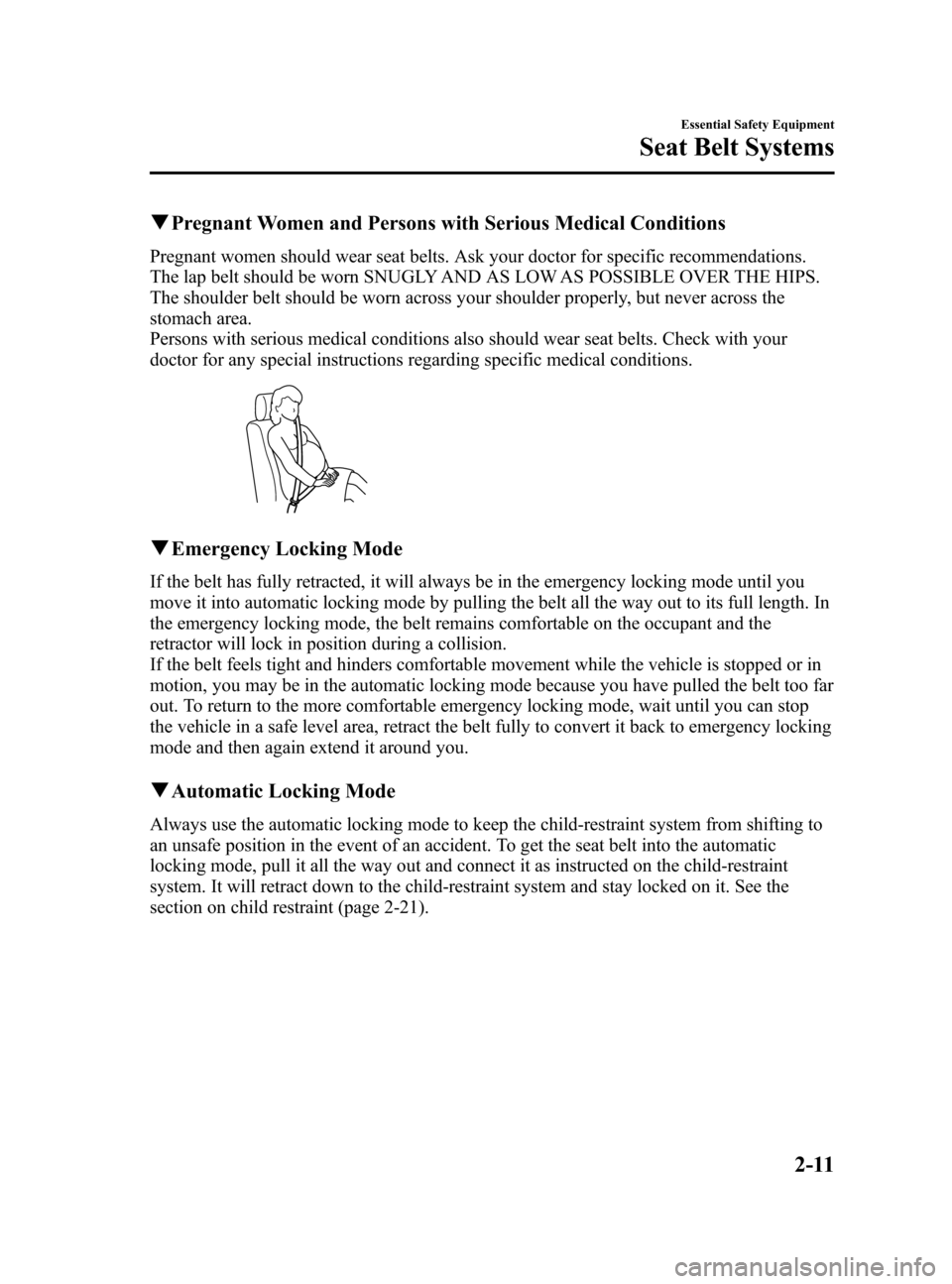
Black plate (25,1)
qPregnant Women and Persons with Serious Medical Conditions
Pregnant women should wear seat belts. Ask your doctor for specific recommendations.
The lap belt should be worn SNUGLY AND AS LOW AS POSSIBLE OVER THE HIPS.
The shoulder belt should be worn across your shoulder properly, but never across the
stomach area.
Persons with serious medical conditions also should wear seat belts. Check with your
doctor for any special instructions regarding specific medical conditions.
qEmergency Locking Mode
If the belt has fully retracted, it will always be in the emergency locking mode until you
move it into automatic locking mode by pulling the belt all the way out to its full length. In
the emergency locking mode, the belt remains comfortable on the occupant and the
retractor will lock in position during a collision.
If the belt feels tight and hinders comfortable movement while the vehicle is stopped or in
motion, you may be in the automatic locking mode because you have pulled the belt too far
out. To return to the more comfortable emergency locking mode, wait until you can stop
the vehicle in a safe level area, retract the belt fully to convert it back to emergency locking
mode and then again extend it around you.
qAutomatic Locking Mode
Always use the automatic locking mode to keep the child-restraint system from shifting to
an unsafe position in the event of an accident. To get the seat belt into the automatic
locking mode, pull it all the way out and connect it as instructed on the child-restraint
system. It will retract down to the child-restraint system and stay locked on it. See the
section on child restraint (page 2-21).
Essential Safety Equipment
Seat Belt Systems
2-11
Mazda3_8T97-EC-04J_Edition1 Page25
Saturday, September 25 2004 2:7 PM
Form No.8T97-EC-04J
Page 35 of 322
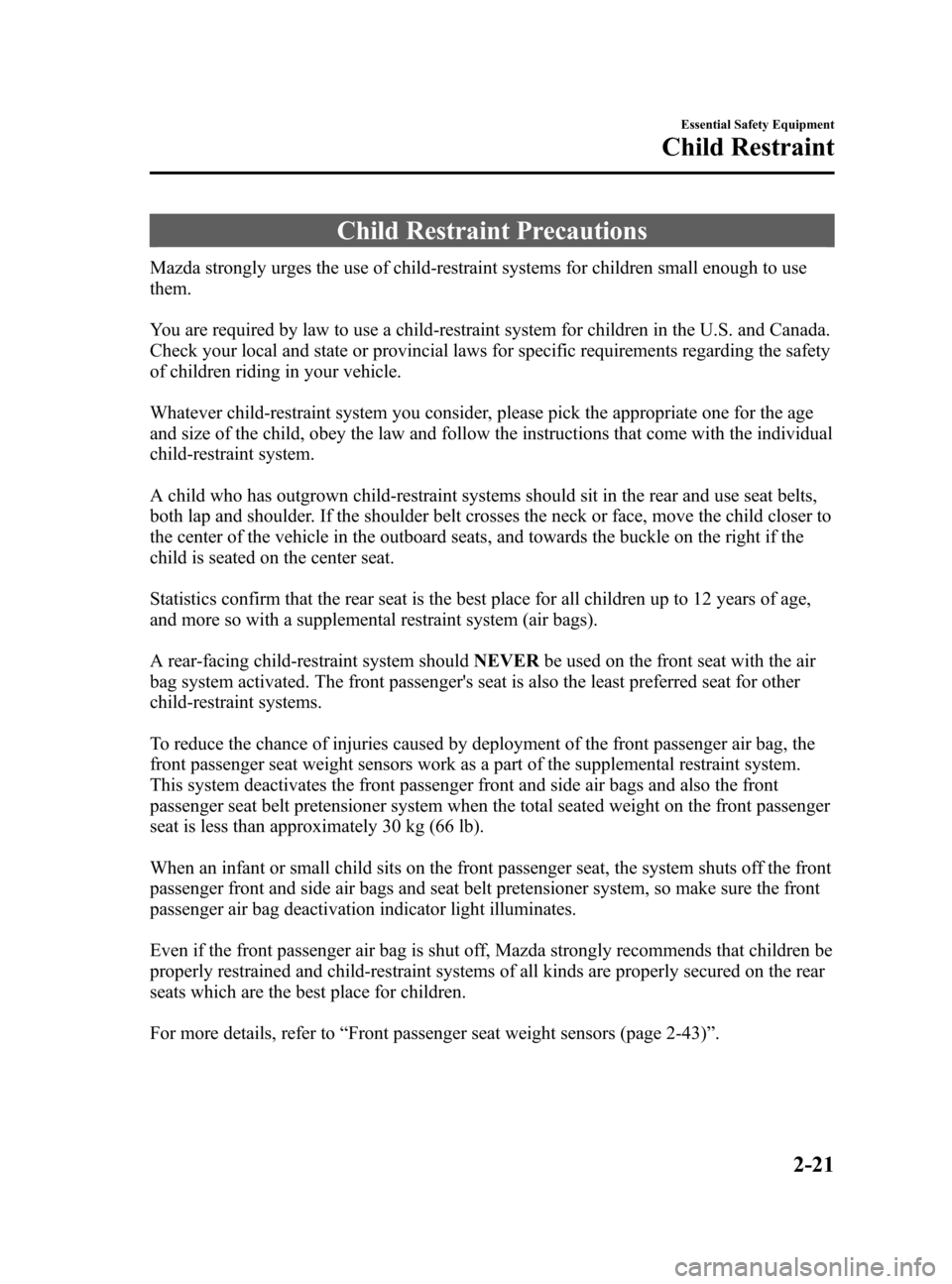
Black plate (35,1)
Child Restraint Precautions
Mazda strongly urges the use of child-restraint systems for children small enough to use
them.
You are required by law to use a child-restraint system for children in the U.S. and Canada.
Check your local and state or provincial laws for specific requirements regarding the safety
of children riding in your vehicle.
Whatever child-restraint system you consider, please pick the appropriate one for the age
and size of the child, obey the law and follow the instructions that come with the individual
child-restraint system.
A child who has outgrown child-restraint systems should sit in the rear and use seat belts,
both lap and shoulder. If the shoulder belt crosses the neck or face, move the child closer to
the center of the vehicle in the outboard seats, and towards the buckle on the right if the
child is seated on the center seat.
Statistics confirm that the rear seat is the best place for all children up to 12 years of age,
and more so with a supplemental restraint system (air bags).
A rear-facing child-restraint system shouldNEVERbe used on the front seat with the air
bag system activated. The front passenger's seat is also the least preferred seat for other
child-restraint systems.
To reduce the chance of injuries caused by deployment of the front passenger air bag, the
front passenger seat weight sensors work as a part of the supplemental restraint system.
This system deactivates the front passenger front and side air bags and also the front
passenger seat belt pretensioner system when the total seated weight on the front passenger
seat is less than approximately 30 kg (66 lb).
When an infant or small child sits on the front passenger seat, the system shuts off the front
passenger front and side air bags and seat belt pretensioner system, so make sure the front
passenger air bag deactivation indicator light illuminates.
Even if the front passenger air bag is shut off, Mazda strongly recommends that children be
properly restrained and child-restraint systems of all kinds are properly secured on the rear
seats which are the best place for children.
For more details, refer to“Front passenger seat weight sensors (page 2-43)”.
Essential Safety Equipment
Child Restraint
2-21
Mazda3_8T97-EC-04J_Edition1 Page35
Saturday, September 25 2004 2:7 PM
Form No.8T97-EC-04J
Page 36 of 322
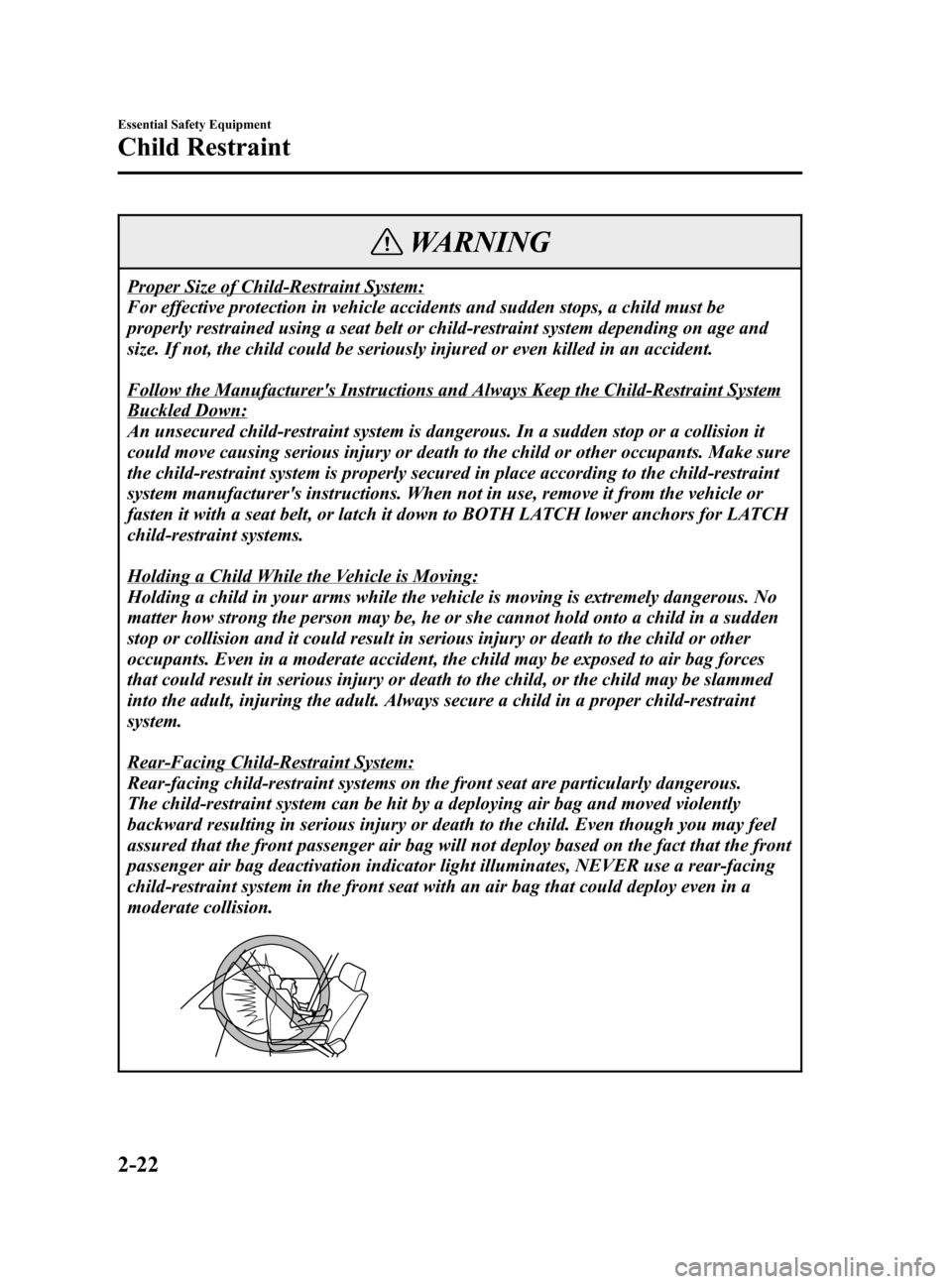
Black plate (36,1)
WARNING
Proper Size of Child-Restraint System:
For effective protection in vehicle accidents and sudden stops, a child must be
properly restrained using a seat belt or child-restraint system depending on age and
size. If not, the child could be seriously injured or even killed in an accident.
Follow the Manufacturer's Instructions and Always Keep the Child-Restraint System
Buckled Down:
An unsecured child-restraint system is dangerous. In a sudden stop or a collision it
could move causing serious injury or death to the child or other occupants. Make sure
the child-restraint system is properly secured in place according to the child-restraint
system manufacturer's instructions. When not in use, remove it from the vehicle or
fasten it with a seat belt, or latch it down to BOTH LATCH lower anchors for LATCH
child-restraint systems.
Holding a Child While the Vehicle is Moving:
Holding a child in your arms while the vehicle is moving is extremely dangerous. No
matter how strong the person may be, he or she cannot hold onto a child in a sudden
stop or collision and it could result in serious injury or death to the child or other
occupants. Even in a moderate accident, the child may be exposed to air bag forces
that could result in serious injury or death to the child, or the child may be slammed
into the adult, injuring the adult. Always secure a child in a proper child-restraint
system.
Rear-Facing Child-Restraint System:
Rear-facing child-restraint systems on the front seat are particularly dangerous.
The child-restraint system can be hit by a deploying air bag and moved violently
backward resulting in serious injury or death to the child. Even though you may feel
assured that the front passenger air bag will not deploy based on the fact that the front
passenger air bag deactivation indicator light illuminates, NEVER use a rear-facing
child-restraint system in the front seat with an air bag that could deploy even in a
moderate collision.
2-22
Essential Safety Equipment
Child Restraint
Mazda3_8T97-EC-04J_Edition1 Page36
Saturday, September 25 2004 2:7 PM
Form No.8T97-EC-04J
Page 37 of 322
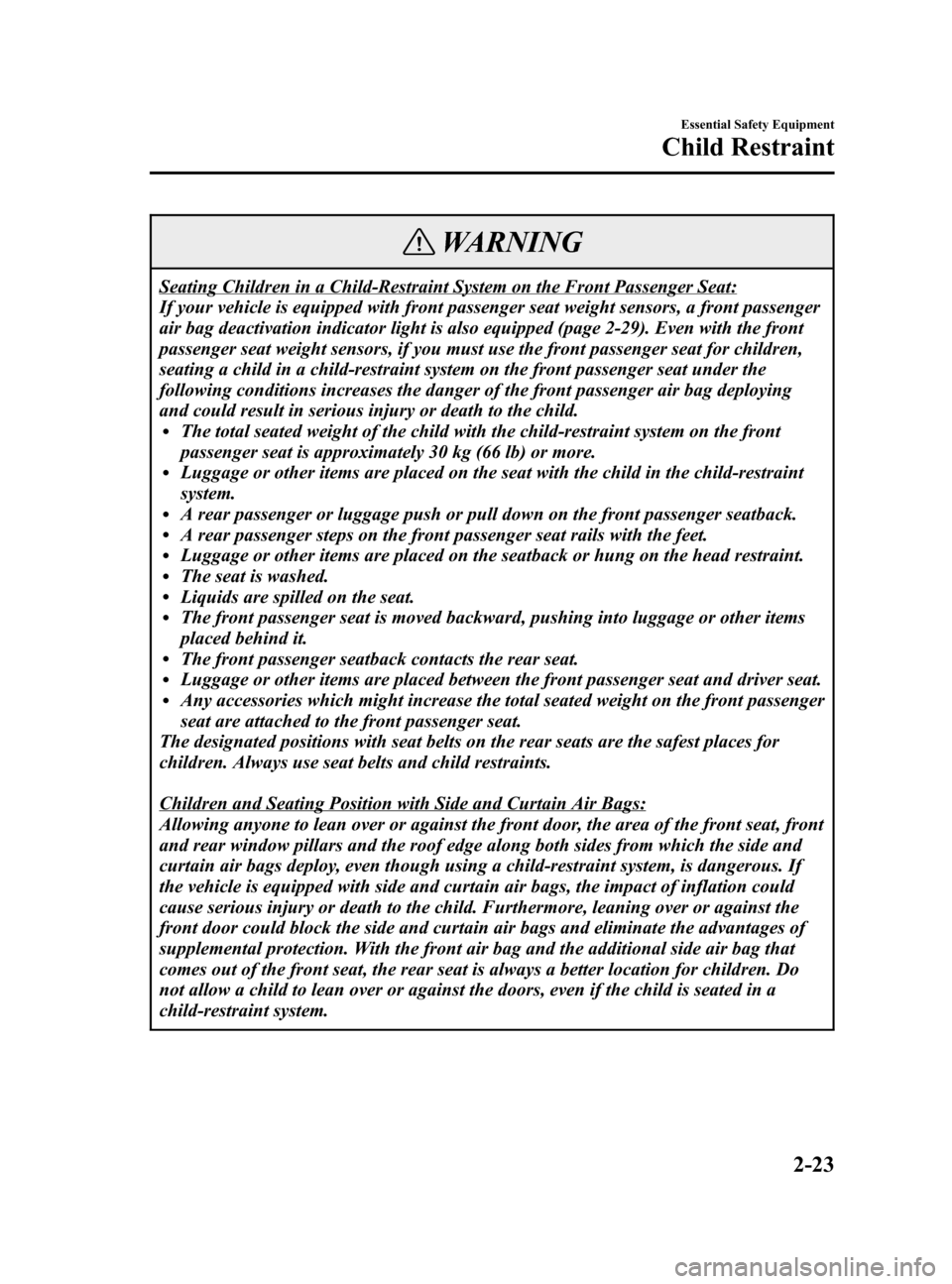
Black plate (37,1)
WARNING
Seating Children in a Child-Restraint System on the Front Passenger Seat:
If your vehicle is equipped with front passenger seat weight sensors, a front passenger
air bag deactivation indicator light is also equipped (page 2-29). Even with the front
passenger seat weight sensors, if you must use the front passenger seat for children,
seating a child in a child-restraint system on the front passenger seat under the
following conditions increases the danger of the front passenger air bag deploying
and could result in serious injury or death to the child.
lThe total seated weight of the child with the child-restraint system on the front
passenger seat is approximately 30 kg (66 lb) or more.
lLuggage or other items are placed on the seat with the child in the child-restraint
system.
lA rear passenger or luggage push or pull down on the front passenger seatback.lA rear passenger steps on the front passenger seat rails with the feet.lLuggage or other items are placed on the seatback or hung on the head restraint.lThe seat is washed.lLiquids are spilled on the seat.lThe front passenger seat is moved backward, pushing into luggage or other items
placed behind it.
lThe front passenger seatback contacts the rear seat.lLuggage or other items are placed between the front passenger seat and driver seat.lAny accessories which might increase the total seated weight on the front passenger
seat are attached to the front passenger seat.
The designated positions with seat belts on the rear seats are the safest places for
children. Always use seat belts and child restraints.
Children and Seating Position with Side and Curtain Air Bags:
Allowing anyone to lean over or against the front door, the area of the front seat, front
and rear window pillars and the roof edge along both sides from which the side and
curtain air bags deploy, even though using a child-restraint system, is dangerous. If
the vehicle is equipped with side and curtain air bags, the impact of inflation could
cause serious injury or death to the child. Furthermore, leaning over or against the
front door could block the side and curtain air bags and eliminate the advantages of
supplemental protection. With the front air bag and the additional side air bag that
comes out of the front seat, the rear seat is always a better location for children. Do
not allow a child to lean over or against the doors, even if the child is seated in a
child-restraint system.
Essential Safety Equipment
Child Restraint
2-23
Mazda3_8T97-EC-04J_Edition1 Page37
Saturday, September 25 2004 2:7 PM
Form No.8T97-EC-04J
Page 38 of 322
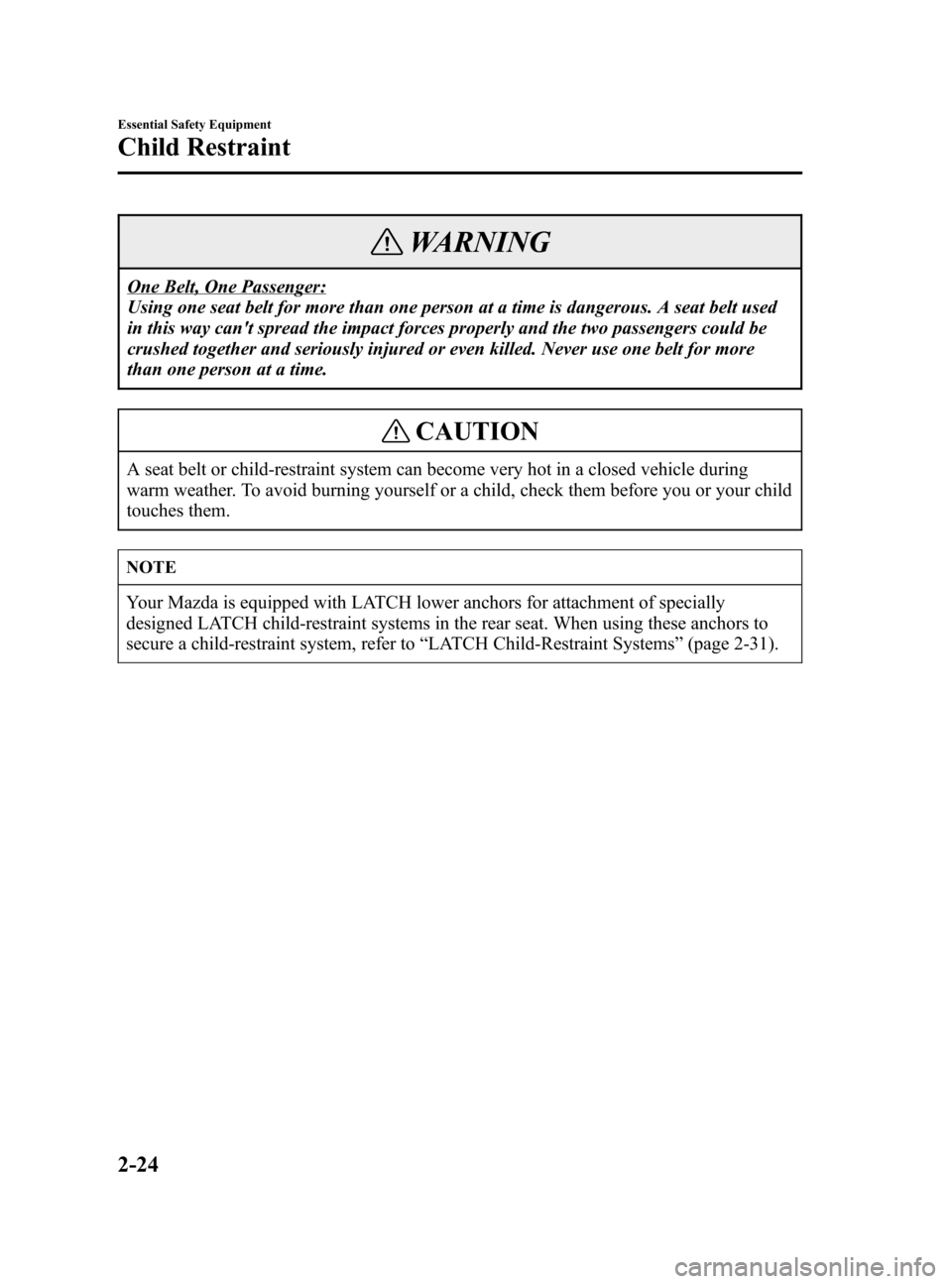
Black plate (38,1)
WARNING
One Belt, One Passenger:
Using one seat belt for more than one person at a time is dangerous. A seat belt used
in this way can't spread the impact forces properly and the two passengers could be
crushed together and seriously injured or even killed. Never use one belt for more
than one person at a time.
CAUTION
A seat belt or child-restraint system can become very hot in a closed vehicle during
warm weather. To avoid burning yourself or a child, check them before you or your child
touches them.
NOTE
Your Mazda is equipped with LATCH lower anchors for attachment of specially
designed LATCH child-restraint systems in the rear seat. When using these anchors to
secure a child-restraint system, refer to“LATCH Child-Restraint Systems”(page 2-31).
2-24
Essential Safety Equipment
Child Restraint
Mazda3_8T97-EC-04J_Edition1 Page38
Saturday, September 25 2004 2:7 PM
Form No.8T97-EC-04J
Page 39 of 322
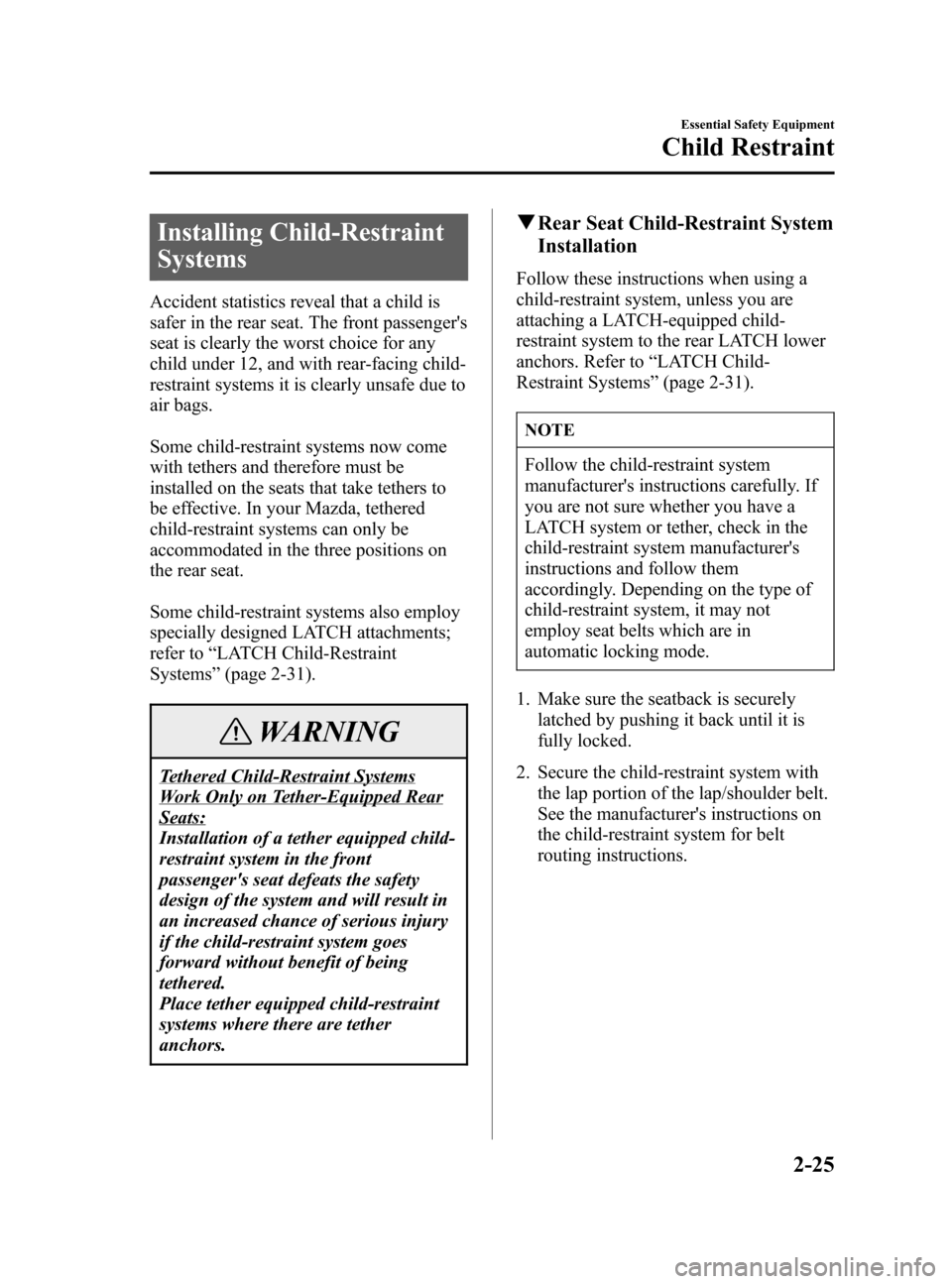
Black plate (39,1)
Installing Child-Restraint
Systems
Accident statistics reveal that a child is
safer in the rear seat. The front passenger's
seat is clearly the worst choice for any
child under 12, and with rear-facing child-
restraint systems it is clearly unsafe due to
air bags.
Some child-restraint systems now come
with tethers and therefore must be
installed on the seats that take tethers to
be effective. In your Mazda, tethered
child-restraint systems can only be
accommodated in the three positions on
the rear seat.
Some child-restraint systems also employ
specially designed LATCH attachments;
refer to“LATCH Child-Restraint
Systems”(page 2-31).
WARNING
Tethered Child-Restraint Systems
Work Only on Tether-Equipped Rear
Seats:
Installation of a tether equipped child-
restraint system in the front
passenger's seat defeats the safety
design of the system and will result in
an increased chance of serious injury
if the child-restraint system goes
forward without benefit of being
tethered.
Place tether equipped child-restraint
systems where there are tether
anchors.
qRear Seat Child-Restraint System
Installation
Follow these instructions when using a
child-restraint system, unless you are
attaching a LATCH-equipped child-
restraint system to the rear LATCH lower
anchors. Refer to“LATCH Child-
Restraint Systems”(page 2-31).
NOTE
Follow the child-restraint system
manufacturer's instructions carefully. If
you are not sure whether you have a
LATCH system or tether, check in the
child-restraint system manufacturer's
instructions and follow them
accordingly. Depending on the type of
child-restraint system, it may not
employ seat belts which are in
automatic locking mode.
1. Make sure the seatback is securely
latched by pushing it back until it is
fully locked.
2. Secure the child-restraint system with
the lap portion of the lap/shoulder belt.
See the manufacturer's instructions on
the child-restraint system for belt
routing instructions.
Essential Safety Equipment
Child Restraint
2-25
Mazda3_8T97-EC-04J_Edition1 Page39
Saturday, September 25 2004 2:7 PM
Form No.8T97-EC-04J